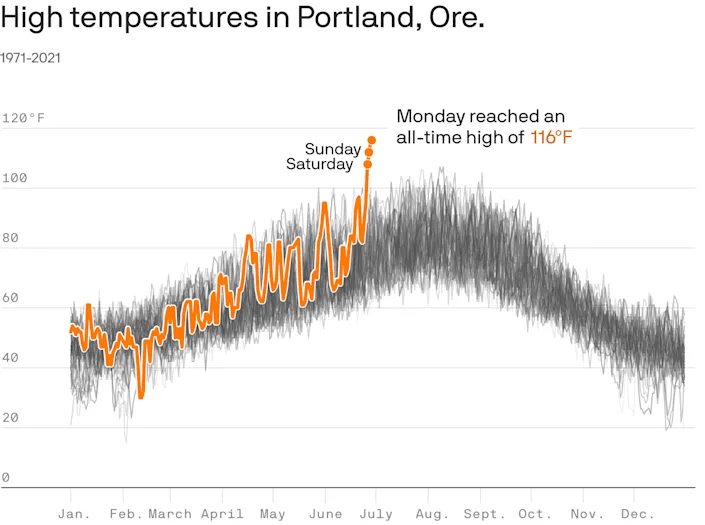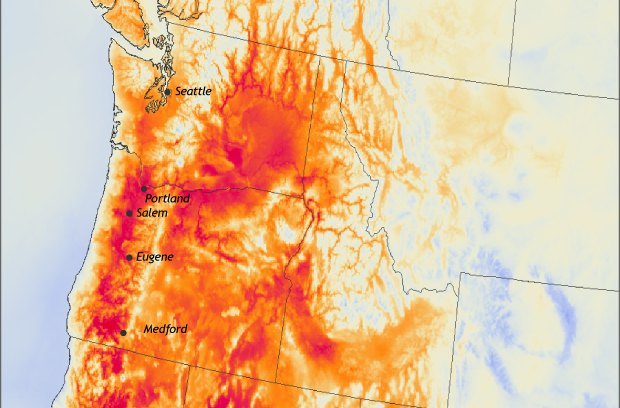by Sophie Purdom and Kim Zou
The impacts of climate change hit home when there’s a record-shattering heat wave.
The Pacific Northwest has experienced three-digit temperatures – breaking all-time records by 7-9ºF. Portland reached 117ºF, Seattle broke to 108ºF, and Lytton, a village in British Columbia, clocked in at 121ºF.
A day after Lytton set the all-time Canadian heat record, a fast-moving wildfire engulfed the town. The heat was so extreme in other regions too that it led to hundreds of deaths across Oregon and Washington, melted the cables powering Portland’s streetcar transit, and buckled the asphalt of state highways.
This particular heat wave was caused by a weather phenomenon known as a “heat dome”, a high pressure system trapping and pushing rising hot air back down. In the 20th century, heat domes were 1 in 1,000 year (0.1%) events. Now, scientists believe that if the world warms another 1.5ºF, the probability could increase to as much as 20%. A study from an international group of climate scientists has concluded that the PNW heat wave “would have been virtually impossible without climate change”.

The dire consequences of extreme heat are not limited to just a three-day event. Heat is also a primary cause for the Western drought. As temperatures rise, the mountain snowpacks providing water to the West have been melting much earlier and faster.
The entire state of California is under some degree of drought with 33% under exceptional drought (the most intense drought classification). Extreme temperatures and associated reservoirs and fields drying up are exacerbating the already precarious challenge of powering electric grids and supplying food.
With everyone flipping on their ACs, hydro dams operating at low water levels, and thermal generators running at lower efficiencies due to the heat, grids around the globe are stressed. Just this past month in the US, Washington state residents experienced rolling blackouts, and Texas, New York, and California all issued mass emergency alerts to conserve energy to prevent power outages.
Hydropower has contributed its fair share to clean energy generation in the West (16% of California energy generation in 2019). But, with water reservoir levels dwindling, grid operators like CAISO are scrambling to find other sources of generation like gas-fired plants.
Meanwhile in California’s Central Valley, which supplies 2/3rds of our fruit and nuts and more than 1/3rd of our vegetables, some farmers are opting to sell water over crops for better profits. Others are letting portions of their fields sit idle. In a state where 40% of farms are irrigated, water can be shockingly scarce and its limited capacity carefully allocated between agriculture and municipal use for cities and towns.
Extreme weather is more than just turning up your AC. As each summer gets hotter and drier, we face a worsening wildfire season and risk breaking the delicate balance of our electricity and agriculture systems. The triple-digit heat wave is sending a clear signal that we’re past the point of pure-play mitigation and need more innovation and infrastructure focused on climate resilience and adaptation. [24×7]
Sophie Purdom and Kim Zou are the creators and authors of the excellent Climate Tech VC newsletter, about the dynamic state of climate tech and venture capital. Climate Tech VC has become a go-to read for entrepreneurs and investors in the climate tech space and Sophie and Kim have their fingers on the pulse of the trends in this rapidly changing sector. Join them Wednesday, Aug 18, at 11 AM EDT, for the Techstars Sustainability Roundtable: The State of Climate Tech and Venture. More info here.




















